Today, we will be discussing a common debate amongst Rolex collectors, which is “blue dial vs white dial Datejust”. But, before we get into that, we are going to be reviewing the Datejust 41, and more specifically, the stainless steel Datejust 41 reference 126300.
Let’s get into it…
HISTORY OF THE DATEJUST
The Rolex Datejust is not just one of Rolex’s most popular collections, it is among the world’s most iconic timepieces.
The luxury dress watch was introduced back in 1945 as a commemoration of Rolex’s 40th anniversary. It had a single complication, an automatically changing date window at the 3 o’clock. At the time, this was a major innovation in the watch industry. The Datejust was the first ever wristwatch with a date that would instantly change at midnight.
With that, the name “Datejust” implies the date will always be just.
While not every Rolex collection has been a hit right out of the gate, the Datejust most certainly was. People were immediately drawn to its waterproof Oyster case, fluted bezel, clean dial, jubilee bracelet, and, of course, its date window.
To give you some depth into the minds of watch buyer’s in the 40s, let’s touch on these features a little more. To do this, we need to go back even further, to 1926, with the creation of the Rolex Oyster.
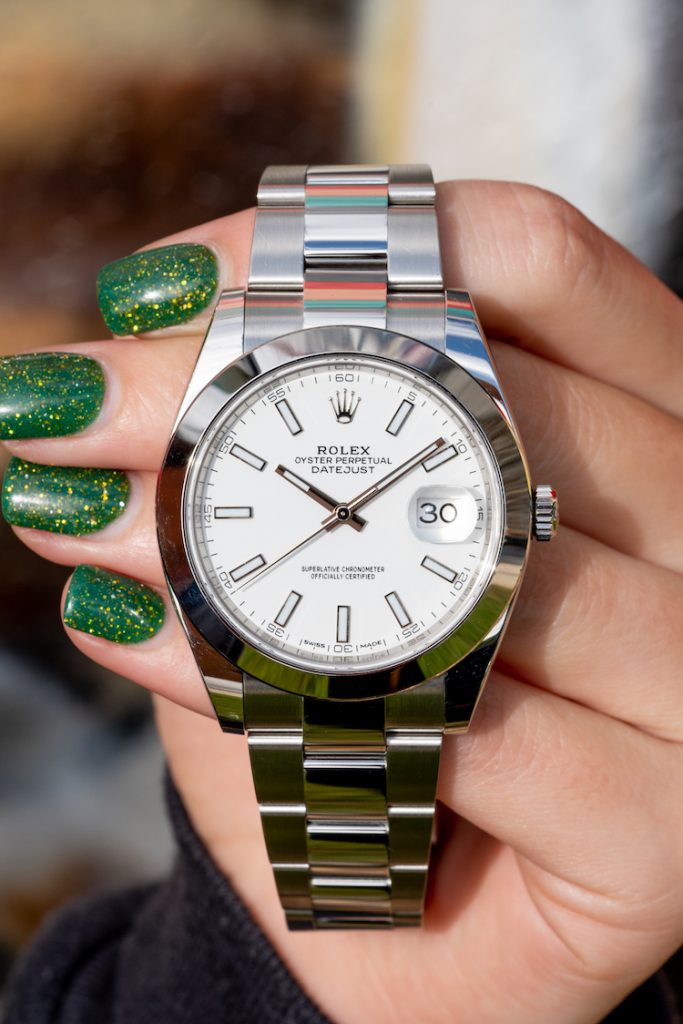
Inspiration from the Rolex Oyster
The Datejust took a lot of inspiration from the Rolex Oyster, which was released in 1926 and was not just Rolex’s first truly waterproof wristwatch, but the first ever in all of watchmaking (this was obviously a major horological event). All Rolex watches from there on out are a descendent of the Oyster, which is why they all have Oyster cases and are guaranteed waterproof to a minimum of 100 meters (330 feet).
The fluted bezel was also first seen on the Rolex Oyster in 1926. Although the design has been “amplified” over the years, it always had that cut gem-like look. A wonderful quality for a dress watch.
The Datejust was also fitted with a self-winding perpetual movement, which was invented and patented by Rolex in 1931 and is now at the heart of every modern automatic watch.
Rolex Datejust’s “First Ever’s”
As we mentioned, the Rolex Datejust was the first watch to have a date complication. But that wasn’t all. The jubilee bracelet was also a brand new creation for the Datejust.
The now incredibly iconic, gorgeous five-piece, semi-circular link Jubilee bracelet was made specifically for the Datejust, hence the name “Jubilee”, which means ‘a special anniversary of an event’. Remember, the Datejust was unveiled upon Rolex’s 40th anniversary.
Cyclops Eye
In 1953, Rolex gave the Datejust an update in the form of a Cyclops eye. The Cyclops eye, which is a 2.5x magnifying lens, was patented by Rolex and made specifically for the Datejust, as it was the only watch with a date complication at that time (the Day-Date wasn’t released until 1956).
The Cyclops eye soon became an epochal Rolex signature feature. From then on, all Rolex watches with date windows have a Cyclops eye.
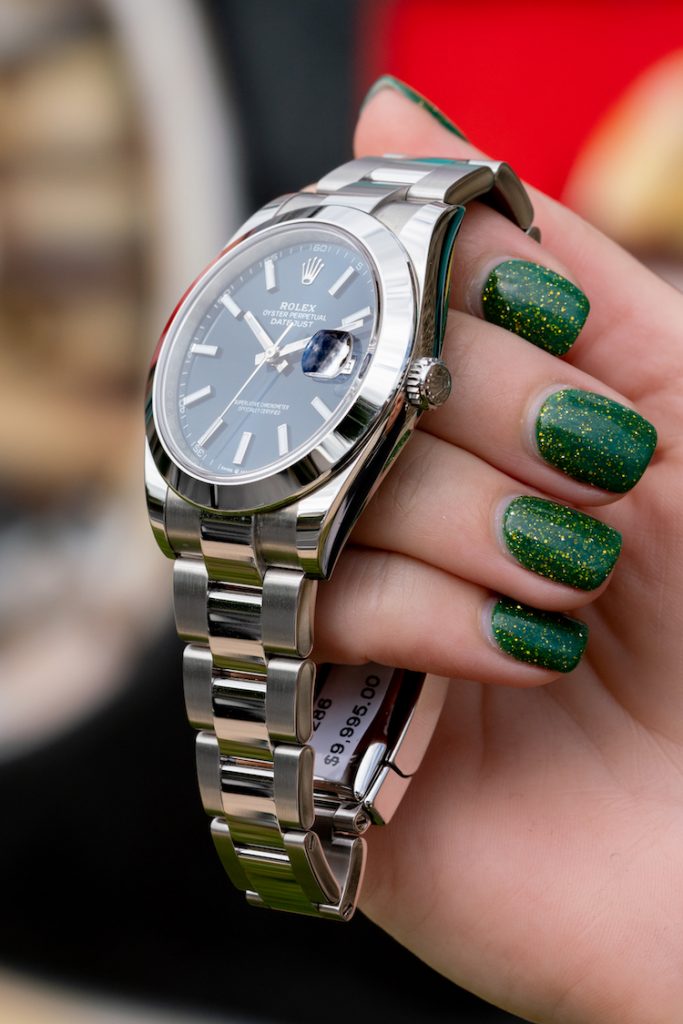
Personalized Features
Throughout history, the Datejust has remained mostly the same. However, Rolex has introduced many configurations, so buyers can personalize a Datejust to their specific taste. There is no other Rolex collection with so many design options.
With the Datejust, you have various options for the bezel, bracelet, material and dial.
Bezel: Smooth, Fluted, Gem-Set
Bracelet: Oyster, President, Jubilee
Material: Oystersteel, Two Tone Rolesor, Yellow Gold, Pink Gold, White Gold
Dial: Light, Dark, Colored, Gem-Set, Pave Diamond
Although the Datejust is the classic dress watch of “reference”, with the various configurations, you can make it lavish, perfectly dressy, or even sporty and more casual. This is especially true when you consider the various size options they’ve implemented over the years.

Datejust Sizes
The classic size of the Datejust is of course 36mm. However, over the decades, the Datejust has been available in sizes ranging from 28mm to 41mm.
The 41mm option came with the Datejust 2 in 2009. It was discontinued and replaced by the watches you see here, the Datejust 41, yet the size remains the same, albeit more refined.
Nowadays, Rolex has three sizes in production, the 31mm (which supplanted the 28mm), the 36mm, and the 41mm.
While the Datejust 36 will forever be the traditional size, the Datejust 41 is clearly the more popular option among modern buyers.
The blue dial and white dial Datejust watches featured here are Datejust 41s, reference 126300.
Datejust 2 to Datejust 41
The Rolex Datejust 41 was unveiled at Baselworld 2016. It was essentially an evolution of the Datejust 2. It shares many similarities, such as its 41mm diameter case size. However, unlike the Datejust 2, it feels and looks less bulky, which was something many collectors complained about.
Like what Rolex did with the Day-Date one year prior, Rolex gave the Datejust 41 a slimmer case, thinner bezel and more tapered lugs. Overall, it made the proportions much more elegant and restrained.
While it may seem like a simple change, it has been a complete game changer for the Datejust’s largest model. Collectors have been swarming to the Datejust 41 ever since its launch, and the popularity of the watch is far greater than the Datejust 2 ever was and it even surpasses the classic 36mm Datejust.
DATEJUST 126300
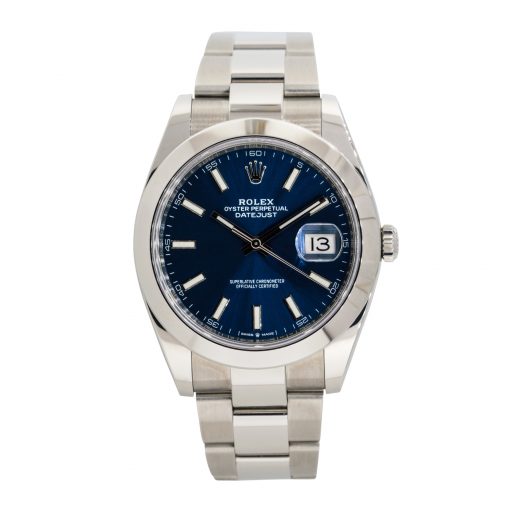
When the Datejust 41 was launched in 2016, it didn’t have a stainless steel option. It wasn’t until 2017 that we were blessed with the Oystersteel Datejust 41, reference 126300. The stainless steel option made for a much more affordable entry into the world of the Datejust 41.
It has since become the most coveted choice.
Now, let’s talk about the specific features of the Datejust 41 in steel, and then we will look at a comparison of the blue dial vs white dial.
OYSTERSTEEL
When it comes to stainless steel, Rolex’s panted Oystersteel is the best in the business. It is extremely highly resistant to corrosion and very hard wearing.
Rolex designed their Oystersteel completely in-house. It belongs to the 904L steel family, which is an alloy typically used in high-tech, chemical, and aerospace industries, as maximum corrosion resistance is vital.
Besides being extremely durable, Rolex’s finishing process is unquestionably exceptional. They are extremely meticulous with their process and standards. So, the beauty of the steel you see on these watches will last in even the harshest environments.
41MM OYSTER CASE
The Oyster case is 41mm in diameter. It wears true to its size as there are no crown guards and the new style of the case is a lot more elegantly “cut”. The lugs are tapered beautifully, the depth is slimmer, and the overall shape is exquisitely ergonomic.
As for waterproofness, like all Oyster cases, it is 100 meters (or 330 feet), so any water activities are a go.
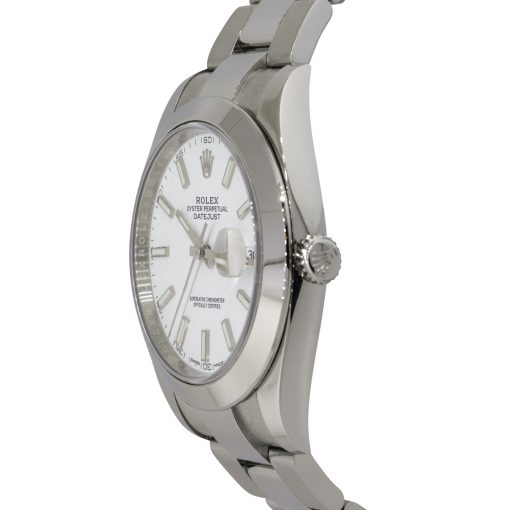
SMOOTH BEZEL
With the Rolex Datejust 126300 you have the option of a smooth or fluted bezel. As it is stainless steel, there is no gem-set option.
The Datejusts you see here clearly have the smooth domed bezel. What we love about the smooth bezel is that it’s extremely versatile. It works both casually and formally. Plus, it provides a very unique look. The word “cool” first comes to mind, whereas a fluted bezel is more dressy and “classy”. It’s a matter of personal preference for which you choose. If you dress casually more than formally, the smooth bezel is a great option.
One thing to note, however, is the smooth bezel can be more of a scratch magnet. The fluted bezel doesn’t show its scratches like a smooth bezel does. That said, most people own their scatches as it is just the nature of having an everyday kind of luxury watch like this.
OYSTER BRACELET
As these two Datejust 126300 have smooth bezels, an Oyster bracelet is the obvious choice. If fluted, the Jubilee would be the better option.
With the Oyster bracelet and the smooth bezel, the Datejust 41 looks particularly sporty. This is especially true because of its 41mm size, which is already more aligned with sports watches.
Overall, it looks sporty, yet it still has the true DNA of a dress watch, so it works well for both. The case having no crown guard and the dial being clean and elegant makes this watch perfectly suitable for formal occasions. As most of our clients here in South Florida dress “casual fresh”, the smooth bezel and Oyster bracelet has proven to be the more popular choice these days. Again, this is all just a matter of preference and all the various configurations Rolex provides look fantastic. You can’t go wrong with any of them.
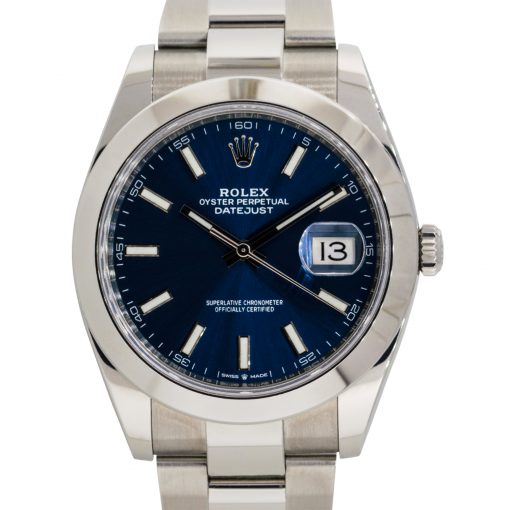
Blue Dial Datejust 41 Pre-Owned
3235 CALIBRE MOVEMENT
Although the refinements to the case from the Datejust 2 to the Datejust 41 are considerable, the biggest change was the movement. With the Datejust 41, you get the 3235 calibre movement.
As always, it is a perpetual self-winding movement with a COSC certification. The best thing about the change is the power reserve is 70 hours, rather than 42 hours of the Datejust 2’s movement.
On top of that, it has all the latest innovations, such as a paramagnetic blue Parachrom hairspring for maximum anti-magnetism and Paraflex shock absorbers for high performance impact resistance. What’s more, the maintenance needs of a 3235 is far superior to the previous movement. You won’t need to service these watches for almost double the amount of time as the previous generation movement.
All in all, if you were shopping between the Datejust 2 and the Datejust 41 on the second hand market, the Datejust 41 is the clear winner in terms of movement.
DIAL
Before we get into the blue vs white dial debate, let’s discuss the similarities, which comprise the entire dial except for the color.
The Datejust 126300’s dial comes in Roman numeral or Batons. These two have the batons. You really can’t go wrong with “sticks”. We think it’s more contemporary.
In any case, both are made from white gold and have a generous supply of lume, as does the hour and minutes hands.
The lume is Chromalight, which is a blue luminescence that glows for up to 8 hours. It “recharges” during the day in the light.
Besides that, the dial is super clean. All you have is a date window at the 3 o’clock, a minute track, and the writing at the top and bottom of the dial that lets you know you are wearing a Rolex Datejust with a COSC certificate.
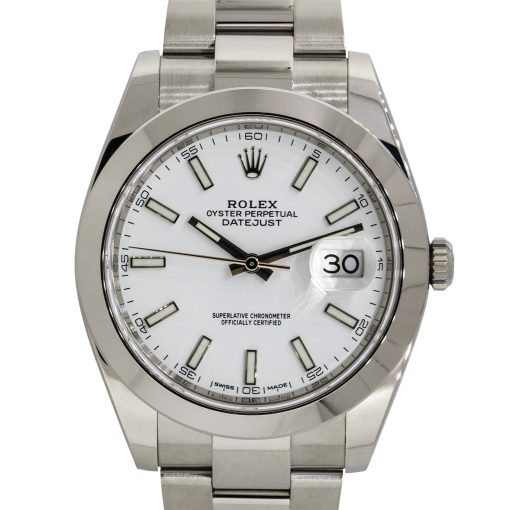
White Dial Datejust 41 Pre-Owned
Swiss Made
For those with a keen eye for detail, you will notice the white dial 126300 doesn’t have the crown between the “Swiss” and “Made” but the blue dial does.
The Rolex crown signifies that the watch has the newest movement. However, this designation of the crown came about in 2018. All watches made in 2018 and on will have the crown, but watches that were produced before that won’t, even if they have the new movement, which the white dial Datejust 41 126300 does have.
So, this white dial Datejust 126300 does have the new movement, calibre 3235, but it was made pre-2018 (ergo, the first year of production), whereas the blue dial is a post-2018 production run.
Will this make a difference to collectibility? One could argue that the pre-2018 white dial model you see here will have more collectibility because it was the first production run. However, we doubt it will make any significant difference to the future collectibility of these watches.
Now, let’s talk about the blue vs white dial Datejust 41.
BLUE DIAL VS WHITE DIAL DATEJUST
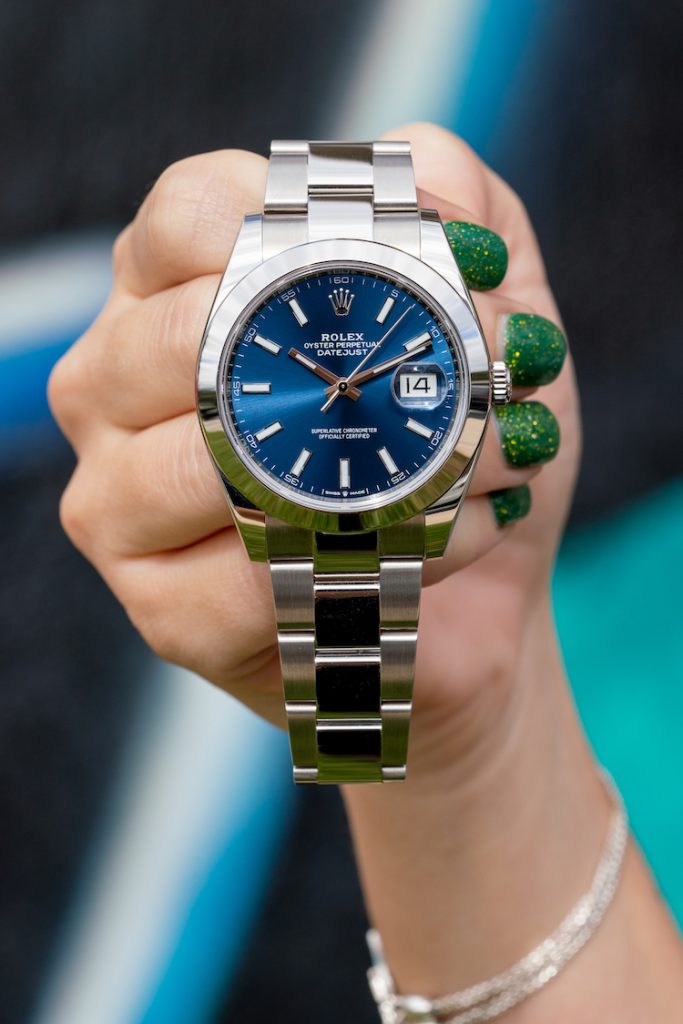
When it comes down to it, the blue dial vs white dial debate is completely subjective. It is completely a matter of personal taste.
However, there are some things to consider, like skin tone and versatility.
First of all, if you are dark-skinned, the white dial might pop on the wrist better, whereas with light skin tones the blue pops. You’ll have to try them on to see.
Versatility wise, we think both the blue and the white dial Datejusts are as versatile as it gets, but many will say the white is more versatile. You will also hear that the white is more of a summer watch while the blue is a fall and winter watch. In our opinion, they are both every day all year round kind of wears.
What else can we say?
Let’s bullet point the rest of the points:
- White dial makes the watch appear slightly bigger on the wrist.
- The blue dial is a sunburst blue which is beautiful and reflects light in a stunning manner.
- White is the most classic and traditional choice. It’s clean and crisp.
- The blue dial is a little more of a smudge magnet, but not as much as the black dial.
- White dials are arguably more legible.
In a perfect world, most collectors would want both the blue dial and the white dial Datejust. They are both timeless, versatile and damn sexy.
If you can, come try them on at our showroom in Boca Raton – Diamonds By Raymond Lee.
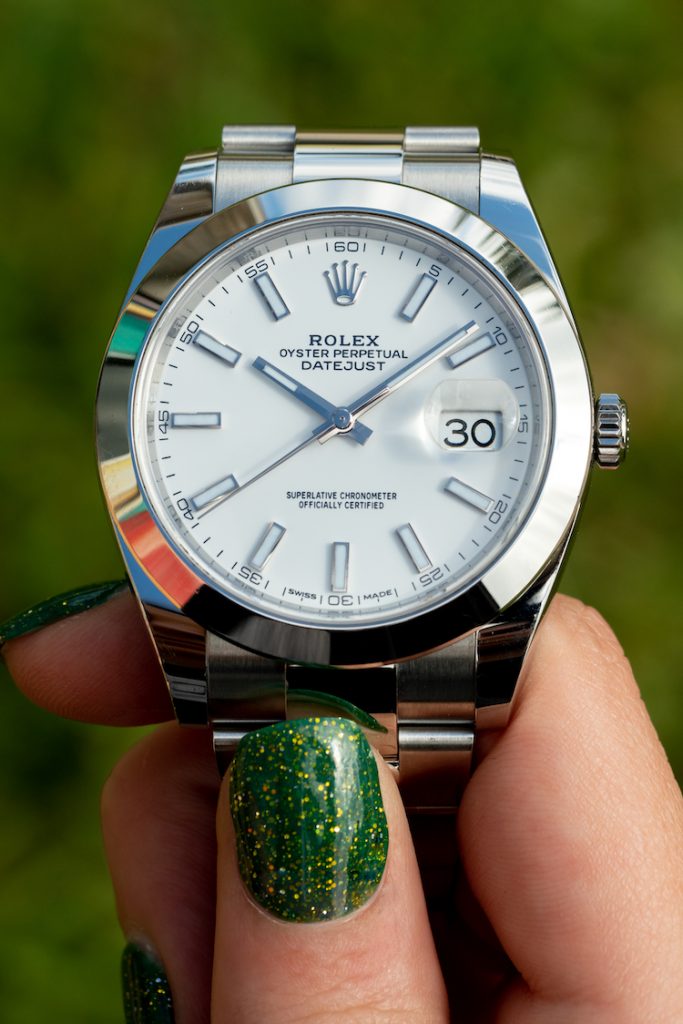
DATEJUST 126300 PRICE
At retail, these watches are selling for $7,650. However, as the blue and white dial Datejust 41s are so extremely popular, they have a very long waiting list.
When Rolex watches have a very long waiting list, that means the second-hand pre-owned market sells them at a premium. At Diamonds By Raymond Lee, we try to keep that premium to a minimum. We are selling both of these watches for $9,995, which is nearly what they will resell for at the current time. Prices are bound to increase with time as these watches have become highly coveted. The point is, this is a very fair and competitive deal.
If you are interested in these watches, you can see the full sales listings below.
Rolex 126300 Datejust 41mm Stainless Steel Blue Dial
Rolex 126300 Datejust 41mm Stainless Steel White Dial Oyster Watch
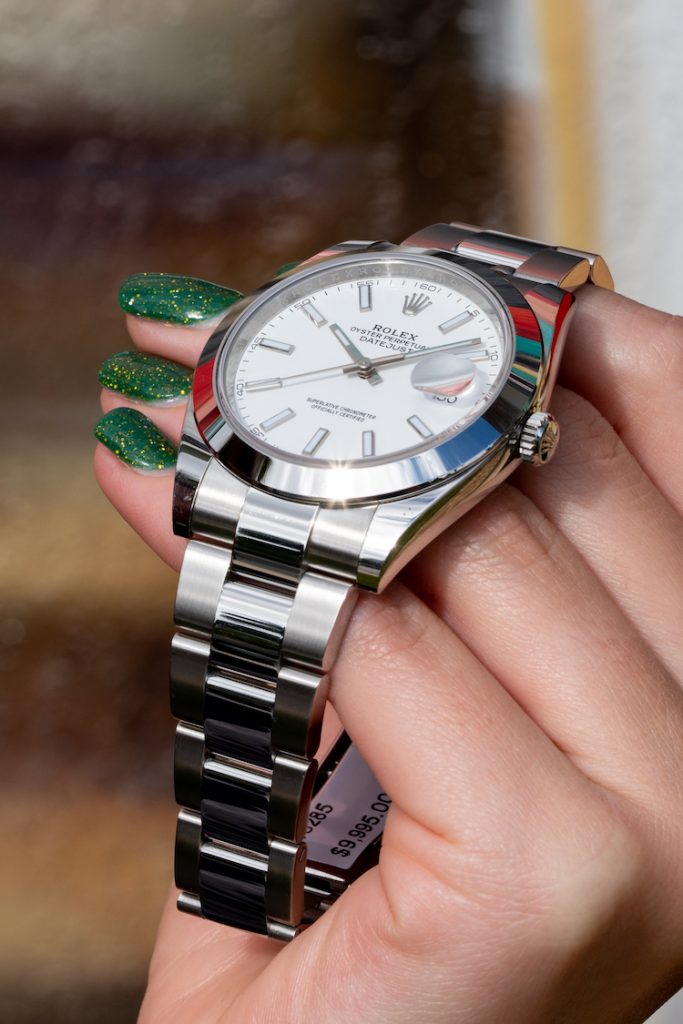
Ten articles before and after
In-depth Review of the Tudor Heritage Black Bay GMT "Pepsi" Watch
Hot Review: Limited Edition Richard Mille RM 011 "Black Phantom" Watch
Historical Review of the Panerai Luminor Marina PAM 104
Romantic Valentine's Day Jewelry For As Low As $299
5 Reasons Why Richard Mille Watches Are So Expensive
6 Types of Rings Every Classy Fashionable Woman Should Own
Hands-On With A New Fully Iced Out Santos de Cartier Skeleton Watch
Why Cuban Link Bracelets & Rings are a Must-Have

